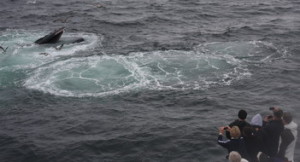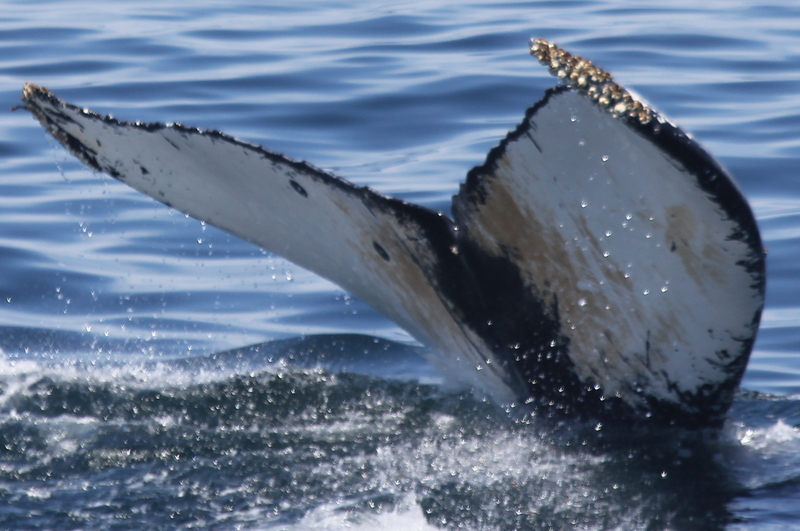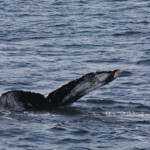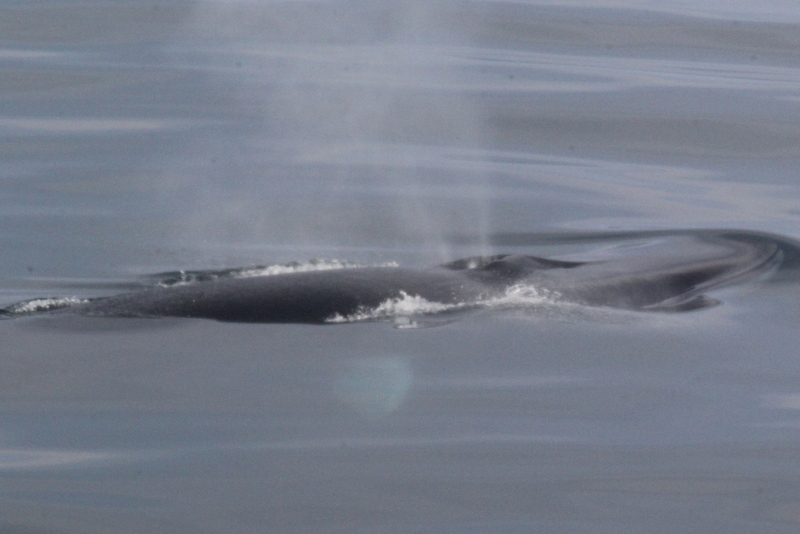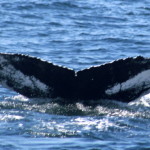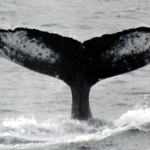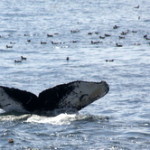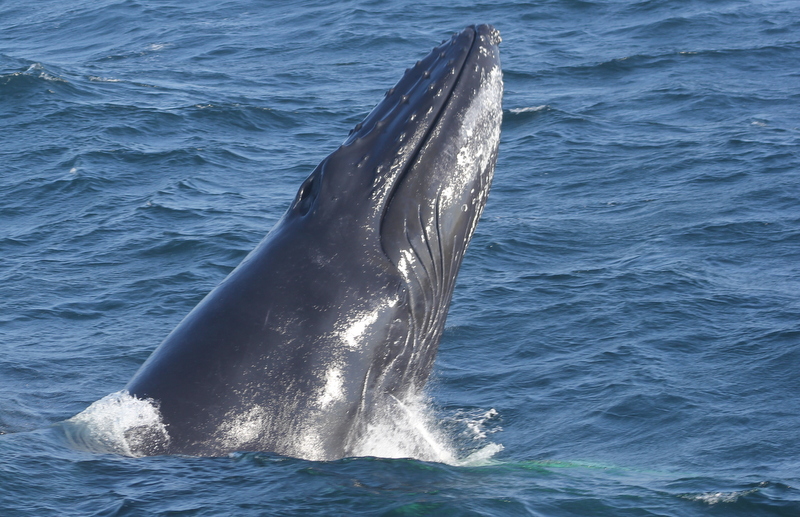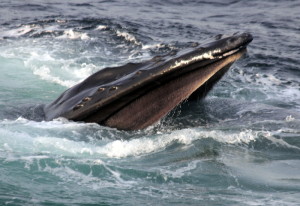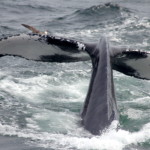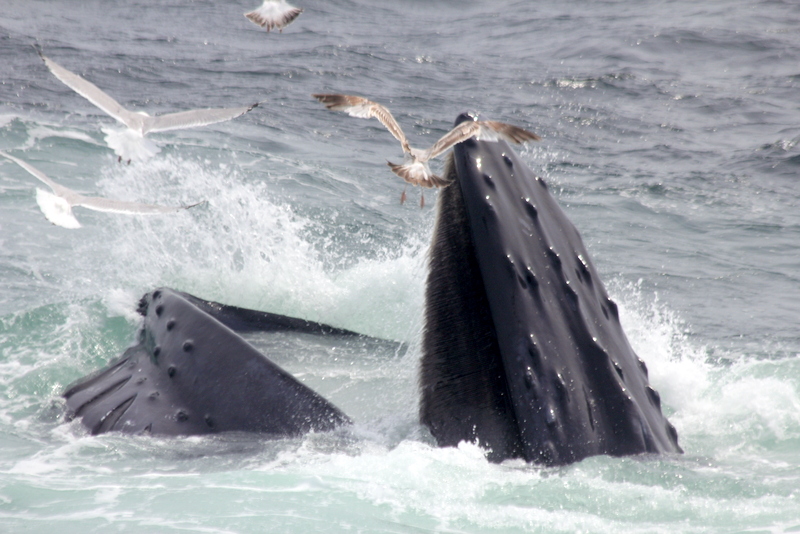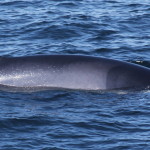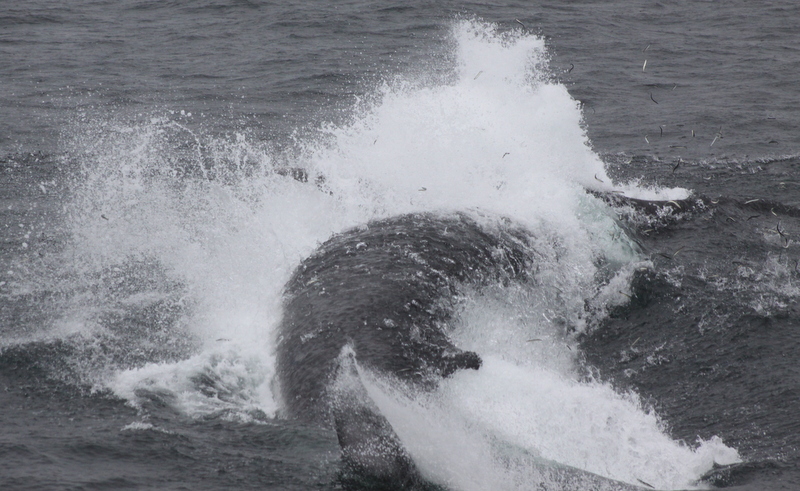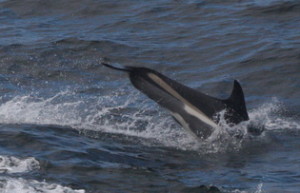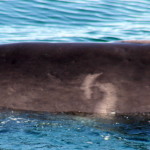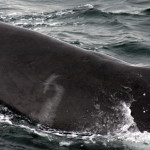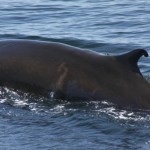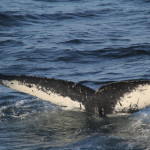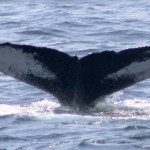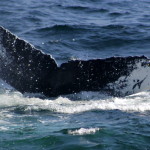Naturalist’s Notebook: June 27 to July 03
* June 27 was a beautiful day to be whalewatching in the western part of Cape Cod Bay. The fog and rain of yesterday morning had passed and the winds of last evening had diminished, leaving the surface of the bay with enough of a swell to remind you you were on the water but not enough to be uncomfortable. It was here, among the pleasant seas, that Measles, Mogul, and Orbit chose to spend their day using great clouds of bubbles to confuse schooling fish, possibly mackerel, into tighter balls so they could make their living on them.
* A large basking shark was also seen in the area, and a finback was spotted beyond Race Point.
* In addition to the feeding humpback whales of June 28, Bullet was seen with her new calf. Bullet’s calf would be about seven months of age, at this point. It is still nursing, as was witnessed by the passengers of the Dolphin 10, and will likely continue to do so until August or September, when Bullet finishes weaning it off of whale milk and onto a diet of small fishes. (A process known more about in theory than in observation.)
* Among the feeding humpback whales was Hancock. Today, rather than blowing the spiral of bubble columns she is known to utilize, she appeared to be blowing bubble rings. When blown deeper, the rings would be large by the time they had reached the surface and she would have already closed her mouth. However, when the rings were seen rising to the surface, still small, she would lunge close enough that her mouth would still be open when she breached the surface of the water.
* And to add to all of the excitement caused by feeding humpback whales, there was an incredible look at a finback whale named Darth.
* In this photo, you can even get a glimpse of the huge animal’s flipper, as well as a feel for how powerful that exhalation must have been. Note the still open blowholes.
* June 29 was bright and sunny and, to the relief of some passengers, CALM. Humpback whales were again seen feeding, though today, deeper beneath the surface. So for most of the day, the bubble clouds could be seen rising to the surface, followed by the whales that would take a couple of breaths and then lift their huge flukes above the surface to dive.
* Orbit, Measles, and Dome (pictured above) were among the whales seen feeding on what appeared to be huge schools of mackerel.
* By late afternoon, however, the fish had moved closer to the surface, attracting huge numbers of herring gulls and shearwaters. A few northern gannets even found their way to the area. It is hard to say whether the birds were drawn there because they had found the school of fish or because they had found the feeding humpbacks. Now, the feeding activity was at the surface: the great leviathons lunging alongside the boat with their huge mouths agape, collecting countless tinker mackerel behind their curtains of baleen before arching and returning to the depths. Then repeating the process again and again and again!
* The sky was bright on June 30, but throughout the day the wind grew, becoming more than just a stiff breeze by midafternoon. Numerous finback whales were sighted throughout the day, making their way to unknown destinations. Very close views were enjoyed of at least three very large finwhales and a single small one.
* If you went to the west-north-west, across the growing south-west winds (and the chop they created), you would have found yourself, with some luck, encountering a humpback whale that was spending some very long periods of time beneath the surface. But if you had gotten there at just the right time, you would have seen this same humpback whale breach. First, a spinning breach, almost as if to get your attention, and then repeated chin-breaches.
* Finback whales and the smaller minke whales were seen in numerous places on July 01. West of the SouthWest Corner and out to the east were several “bunches” of minkes. Finwhales were found inside the Race and down the backside. Hancock was spotted again today, blowing bubble clouds to corral schooling fish closer together. Timberline was seen not just blowing bubbles, but also kick-feeding.
* A four species day on July 02. Feeding humpback whales were joined by minke whales and surface-feeding finback whales. And, today, there were also several dozen atlantic white-sided dolphins.
* The highlight of the day was the reappearance of our friend Loon. This finback whale has a sighting history that goes back to 1980. There are one or two other finners with sighting records as long or even longer, but none of them has been sighted with the consistency of Loon. Named for this marking on the left side of its body, Loon is most frequently spotted when other whales are not close to the Cape, but is also seen when the feeding is good.
* Imagine the sound of a fog-horn. Now, imagine the air so dense, so thick, that you can barely see the bow of your boat. That was how July 03 began. Calm water, but the air nearly as thick. A faint sound is heard. From where? Listen again, it’s there. Off to the starboard. A third time. It is the spout of a whale. So you listen for it some more, peering into the haze. It takes a moment for your eyes to adjust but then you see it, the dark, long outline of a finback whale surfacing gently on the flat seas. It breathes two or three more times before the dark shape thickens as it arches and dives, removing it from view.
* As you make your way further from shore, the flat seas take on a sizeable swell. The fog has lifted a little, allowing you to see a couple of boat-lenths in any direction. That’s how you found the minke whales. A third of a dozen of them surround the boat. Without the backdrop of a huge expanse of water, these animals actually begin to look like the large creatures they are. They appear out of the fog and disappear beneath the depths so rapidly that you can’t really tell how many are around you.
* Continuing on, toward the northeast, you happen upon a large, triangular fin slowly pushing through the surface of the water. As you near, the features of the basking shark are made more clear. It swims along, gently, oblivious to your presence.
* The fog lifts a little more. And, quite suddenly, there are seventy to a hundred humpback whales kick-feeding all around you. More than seventy humpbacks within a four mile radius of your boat! All of them actively making a superb living on small, schooling fish: blowing bubbles beneath the school, then surfacing to slap their tails repeatedly before diving down beneath the fish once more to open their mouths and lunge through the school, taking in as much of the fish and seawater as they can.
* That was the story of July 03. Most of the afternoon and evening trips saw at least 30 feeding humpback whales! Jumanji, Cloud, and Wyoming were among the more commonly sighted.






